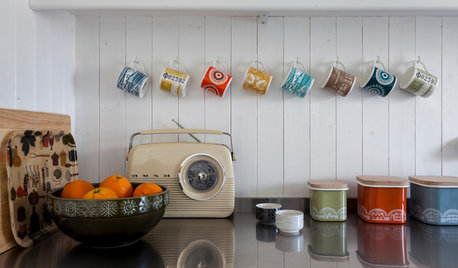the dreaded week...
dragon_kite
13 years ago
Related Stories

LIFEYou Said It: ‘Yikes, Tough Crowd’ and Other Quotes of the Week
Some of our favorite quotes this week came straight from the Comments section. See the stories and have your own say
Full Story
INDUSTRIAL STYLEKitchen of the Week: Style Trumps Ease in a San Francisco Loft
What’s a little ladder climbing when you’ve got a gorgeous-looking kitchen design like this?
Full Story
KITCHEN OF THE WEEKKitchen of the Week: 27 Years in the Making for New Everything
A smarter floor plan and updated finishes help create an efficient and stylish kitchen for a couple with grown children
Full Story
MIDCENTURY HOMESKitchen of the Week: Walls Come Down in a Colorful Midcentury Space
In this modern home, a galley kitchen opens up and connects to dining and family areas with a roomy bamboo island
Full Story
COLORFUL KITCHENSKitchen of the Week: Bold Color-Blocking and a Central Banquette
Glossy red cabinets contrast with black surfaces and white seating in this cooking-dining space designed for entertaining
Full Story
SMALL KITCHENSKitchen of the Week: A Small Galley With Maximum Style and Efficiency
An architect makes the most of her family’s modest kitchen, creating a continuous flow with the rest of the living space
Full Story
FEEL-GOOD HOMERegain Calm With a New Weekly Routine
Having a day-by-day housekeeping schedule makes the chores a lot more manageable
Full Story
KITCHEN DESIGNNew This Week: 3 Modern Kitchens With Something Special
Looking to make your kitchen feel unique? Look to these spaces for inspiration for tile, style and more
Full Story
PATIO OF THE WEEKKoi Glide Around a Tranquil Garden's Moat
This idyllic retreat combines lush plantings, statues and moving water for a serene backyard scene
Full Story
LIVING ROOMSNew This Week: 3 Sunrooms Straight Out of Our Dreams
Heated floors, comfy furniture and walls of windows make these recently uploaded sunrooms the places of our sun-drenched fantasies
Full StoryMore Discussions








orchidnick
arthurm
Related Professionals
Quincy Landscape Architects & Landscape Designers · Anderson Landscape Contractors · Hickory Hills Landscape Contractors · Kaneohe Landscape Contractors · Las Vegas Landscape Contractors · Waterford Landscape Contractors · Norridge Landscape Contractors · Exeter General Contractors · Mentor General Contractors · Newington General Contractors · Norfolk General Contractors · Port Huron General Contractors · San Bruno General Contractors · Springfield General Contractors · Williston General Contractorsarthurm
stitzelweller
dragon_kiteOriginal Author
westoh Z6
meg_w (9b) Bradenton
ateles
highjack
dragon_kiteOriginal Author
orchid527
orchidnick
westoh Z6
orchid527
dragon_kiteOriginal Author
dragon_kiteOriginal Author
westoh Z6
xmpraedicta
orchidnick
cjwatson
orchidnick
xmpraedicta
cjwatson
jane__ny
orchidnick
highjack
orchidnick
highjack
orchidnick
dragon_kiteOriginal Author
jane__ny
symbie
orchidnick
meg_w (9b) Bradenton
ateles
cjwatson
dragon_kiteOriginal Author
orchidnick
orchid527
dragon_kiteOriginal Author
orchidnick
westoh Z6
orchidnick
orchid527
westoh Z6
orchid527
westoh Z6
arthurm
stitzelweller
westoh Z6